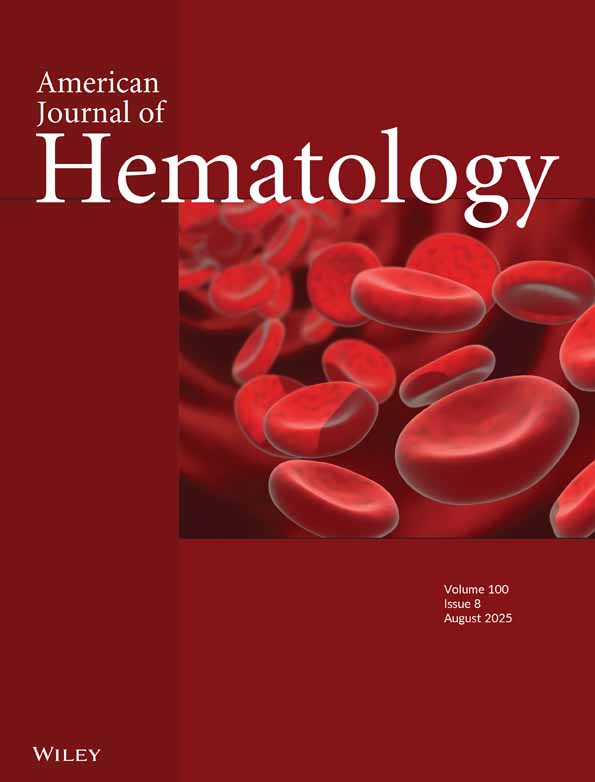Genotypic analysis using a Y-chromosome-specific probe following bone marrow transplantation
Corresponding Author
Dr. Hiroko Morisaki
Department of Pathological Pharmacology, Institute of Medical Science, University of Tokyo, Tokyo, Japan
Department of Pathological Pharmacology, Institute of Medical Science, University of Tokyo, 4-6-1 Shirokanedai, Minato-ku, Tokyo 108, JapanSearch for more papers by this authorTakayuki Morisaki
Department of Pathological Pharmacology, Institute of Medical Science, University of Tokyo, Tokyo, Japan
Search for more papers by this authorYutaka Nakahori
Department of Congenital Abnormalities Research, National Children's Medical Research Center, Tokyo, Japan
Search for more papers by this authorHiromi Ogura
Department of Pathological Pharmacology, Institute of Medical Science, University of Tokyo, Tokyo, Japan
Search for more papers by this authorHitoshi Kanno
Department of Pathological Pharmacology, Institute of Medical Science, University of Tokyo, Tokyo, Japan
Search for more papers by this authorKenzaburo Tani
Department of Pathological Pharmacology, Institute of Medical Science, University of Tokyo, Tokyo, Japan
Search for more papers by this authorHideki Kodo
Department of Pathological Pharmacology, Institute of Medical Science, University of Tokyo, Tokyo, Japan
Search for more papers by this authorHisaichi Fujii
Department of Pathological Pharmacology, Institute of Medical Science, University of Tokyo, Tokyo, Japan
Search for more papers by this authorShigetaka Asano
Department of Pathological Pharmacology, Institute of Medical Science, University of Tokyo, Tokyo, Japan
Search for more papers by this authorShiro Miwa
Department of Pathological Pharmacology, Institute of Medical Science, University of Tokyo, Tokyo, Japan
Search for more papers by this authorCorresponding Author
Dr. Hiroko Morisaki
Department of Pathological Pharmacology, Institute of Medical Science, University of Tokyo, Tokyo, Japan
Department of Pathological Pharmacology, Institute of Medical Science, University of Tokyo, 4-6-1 Shirokanedai, Minato-ku, Tokyo 108, JapanSearch for more papers by this authorTakayuki Morisaki
Department of Pathological Pharmacology, Institute of Medical Science, University of Tokyo, Tokyo, Japan
Search for more papers by this authorYutaka Nakahori
Department of Congenital Abnormalities Research, National Children's Medical Research Center, Tokyo, Japan
Search for more papers by this authorHiromi Ogura
Department of Pathological Pharmacology, Institute of Medical Science, University of Tokyo, Tokyo, Japan
Search for more papers by this authorHitoshi Kanno
Department of Pathological Pharmacology, Institute of Medical Science, University of Tokyo, Tokyo, Japan
Search for more papers by this authorKenzaburo Tani
Department of Pathological Pharmacology, Institute of Medical Science, University of Tokyo, Tokyo, Japan
Search for more papers by this authorHideki Kodo
Department of Pathological Pharmacology, Institute of Medical Science, University of Tokyo, Tokyo, Japan
Search for more papers by this authorHisaichi Fujii
Department of Pathological Pharmacology, Institute of Medical Science, University of Tokyo, Tokyo, Japan
Search for more papers by this authorShigetaka Asano
Department of Pathological Pharmacology, Institute of Medical Science, University of Tokyo, Tokyo, Japan
Search for more papers by this authorShiro Miwa
Department of Pathological Pharmacology, Institute of Medical Science, University of Tokyo, Tokyo, Japan
Search for more papers by this authorAbstract
To monitor successful engraftment after bone marrow transplantation, we performed Southern hybridization analysis or dot blot analysis of DNA in a set of sex-mismatched cases using a Y-chromosome-specific DNA probe (pHY10). This method was extremely sensitive and rapid for checking which cells contain the Y-chromosome. Using this probe, analysis of cells from peripheral blood and bone marrow after transplantation demonstrated the usefulness of confirming engraftment of donor cells and of detecting mixed lymphohematopoietic chimerism.
References
- 1 Good RA, Kapoor N, Reiscer Y: Bone marrow transplantation—An expanding approach to treatment of many diseases. Cell Immunol 82: 36, 1983.
- 2 Blume KG, Beutler E, Bross KJ, Schmidt GM, Spruce WE, Teplitz RL: Genetic markers in human bone marrow transplantation. Am J Hum Genet 32: 414, 1980.
- 3 Botsein D, White RL, Skolnick M, Davis RW: Construction of a genetic linkage map using restriction fragment length polymorphisms. Am J Hum Genet 32: 314, 1980.
- 4 Ginsburg D, Antin JH, Smith BR, Orkin SH, Rappeport JM: Origin of cell population after bone marrow transplantation. J Clin Invest 75: 596, 1985.
- 5 Knowlton RG, Brown VA, Braman JC, Barker D, Schumm JM, Murray C, Takvorian T, Rita J, Donis-Keller R: Use of highly polymorphic DNA probes for genotypic analysis following bone marrow transplantation. Blood 62: 378, 1986.
- 6 Cooke H: Repeated sequence specific to human males. Nature 262: 182, 1976.
- 7 Nakahori Y, Mitani K, Yamada M, Nakagome Y: A human Y-chromosome specific repeated DNA family (DYZ1) consists of a tandem array of pentanucleotides. Nucleic Acids Res 14: 7569, 1986.
- 8 Morisaki H, Morisaki T, Nakahori Y, Ogura H, Kanno H, Tani K, Fujii H, Asano S and Miwa S: Brief note. Use of Y-chromosome specific probe for detection of engraftment of bone marrow transplantation. Acta Haematol Jpn (in press).
- 9 Orkin SH, Alter BP, Altay C, Mahoney MJ, Lazarus H, Hobbins JC, Nathan DG: Application of endonuclease mapping to the analysis and prenatal diagnosis of thalassemias caused by globingene depletion. N Engl J Med 299: 166, 1978.
- 10 Southern EM: Detection of specific sequences among DNA fragments separated by gel electrophoresis. J Mol Biol 98: 503, 1975.
- 11 Leary JJ, Brigati DJ, Ward DC: Rapid and sensitive colorimetric method for visualizing biotin-labeled DNA probes hybridized to DNA or RNA immobilized on nitrocellulose: Bio-blots. Proc Natl Acad Sci USA 80: 4045, 1983.
- 12 Lau Y-F, Huang JC, Dozy AM, Kan YW: A rapid screening test for antenatal sex determination. Lancet 1: 14, 1984.




